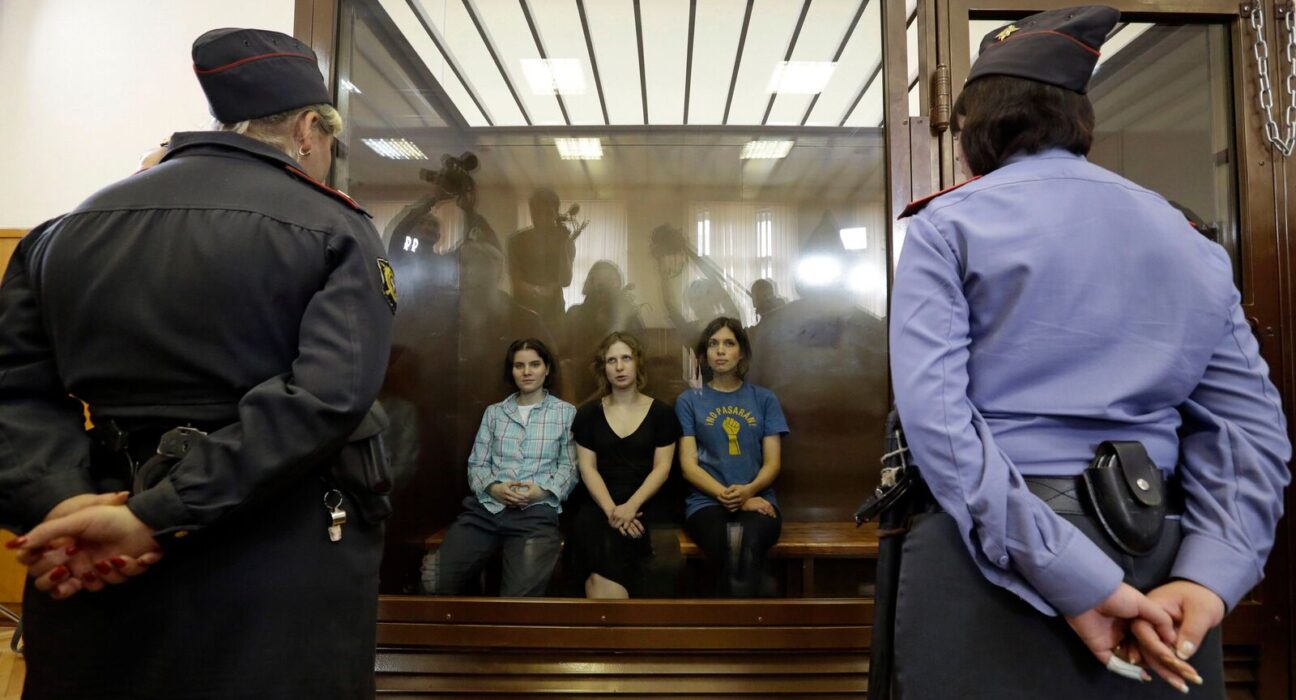“This machine kills fascists”: The simple but powerful slogan emblazoned on Woody Guthrie’s guitar amid a particularly patriotic streak during World War II has spawned numerous imitations and copycats in the intervening decades. But its message—that art has the strength to challenge authoritarianism in any guise—still rings true. Whether the fascist label applies to Mr. Putin may be a matter up for debate, but his fear of the arts is now undeniable.
Last week, the FSB (Russia’s internal security service and successor to the KGB) launched a campaign across the country interrogating contemporary artists and raiding their homes and studios. More than 30 in at least seven cities—including Moscow and St. Petersburg—were caught up in the agency’s actions, though those numbers are no doubt higher considering that several refused to be identified in interviews with local news outlets out of fear of reprisal.
The pretense for these interrogations revolves around the case of Pyotr Verzilov—former member of the activist art collective Pussy Riot and publisher of the independent, anti-Putin media outlet MediaZona—with whom the targeted artists allegedly had connections. Mr. Verzilov, who is currently fighting in Ukraine against the Russian invasion, now seems to be the target of a treason case in his homeland—this after a separate incident last year when he was convicted and sentenced in absentia to 8½ years in prison for opposing that “special military operation.” (According to multiple media reports, that sentence has since been canceled and the case set for retrial.)
This is not the first time that Mr. Verzilov has faced the ire of the Kremlin. Following a protest at the 2018 World Cup against Russian police brutality, Mr. Verzilov was likely poisoned—a tactic that has recently become a morbid calling card of state-sponsored retaliation against those who oppose the Putin regime.
What is new here is the wide net that the state has cast to strike fear in anyone with even the most tenuous ties to Mr. Verzilov. Not only were other members of Pussy Riot—Olga Kuracheva, Olga Pakhtusova and Rita Flores—and Mr. Verzilov’s mother targeted by the FSB, but many in the arts community who knew of Mr. Verzilov only through social media, or didn’t know him at all, were subjected to search and/or questioning. Though some are lesser-known creators, others are well established in the art world, among them performance and installation artist Denis Mustafin; conceptual artist Anatoly Osmolovsky; street artist and 2023 Artist of the Year at the Cosmoscow art fair Artem Filatov; and Nailya Allakhverdiyeva, director of the Perm Museum of Contemporary Art, which was just named Museum of the Year by the Art Newspaper Russia.
The true common denominator among those who have found themselves at the receiving end of this intimidation is that they all represent creative threats to the established powers in Moscow. Mr. Mustafin has protested the prosecution of artists under a criminal code dealing with the incitement of hatred or enmity; Mr. Osmolovsky’s work has tackled sexuality in the notoriously discriminatory country; Mr. Filatov has pointed out the deaths of children in the current conflict; Ms. Allakhverdiyeva pushed back against authorities who looked to stymie the growth of her Urals-based cultural institution. Many others have criticized the invasion of Ukraine, whether directly or obliquely.
The chilling effect on the arts has been quickly felt. Mr. Osmolovsky, for one, left the country after the raid, and many of those targeted have refused to speak to the media. One can only imagine the fear the FSB’s actions have instilled in creators with smaller profiles. Picasso, famously defiant, remained in Paris and continued working during the Nazi occupation, knowing his profile was large enough to immunize him from Hitler’s wrath—the world had its eyes on him. Russia’s artists of humbler standing don’t currently have that indemnity.
This crackdown, coinciding with an election whose results were written well before a single ballot was cast, presages an even more ruthless approach to dissent from Mr. Putin. In an interview with the German news outlet DW, Mr. Osmolovsky said he believes that there will soon be widespread show trials of artists. Between the fleeing artists and government control of what passes aesthetic muster, comparisons to Stalin’s tyranny or the Reich and its position on “degenerate” art aren’t misplaced.
Terrifying as this all is, it’s also a sign that art, especially under authoritarianism, still holds power—if it didn’t Mr. Putin and his ilk wouldn’t be moving so aggressively against those who oppose his ideas. While much of the West understands Russia’s malevolence on the world stage, inside that country there are still plenty who believe in its geopolitical virtues, or even go so far as to espouse neo-Russian-chauvinist views. But clearly the Kremlin sees artists at home changing minds when it comes to Ukraine, as well as any number of other subjects that those now in power refuse to budge on. And in the eyes of Putin and his forces, if Russia’s political leaders can’t win the war of ideas—as the Alexei Navalny-inspired flashmobs at polling places on election day would suggest—they must silence the voices of the opposition.
Not since Stalin’s Great Purge has it been this dangerous for artists in Russia, but never has their work been more important. The world must watch what is happening across that country, not only to call out abuses of power against creators, but to protect them as well. They may not be Picasso, but with our focus on them, Russia’s artists may have the chance to continue resisting tyranny from within.
Mr. Kelly is the Journal’s associate Arts in Review editor.

